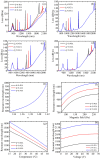A Multi-Parameter Integrated Sensor Based on Selectively Filled D-Shaped Photonic Crystal Fiber
- PMID: 35454504
- PMCID: PMC9026482
- DOI: 10.3390/ma15082811
A Multi-Parameter Integrated Sensor Based on Selectively Filled D-Shaped Photonic Crystal Fiber
Abstract
We propose and numerically investigate a multi-parameter integrated sensor based on a selectively filled D-shaped photonic crystal fiber (PCF). The simple structure can be used to comprehensively detect refractive index, magnetic field, temperature, and voltage. According to the surface plasmon resonance and directional coupling effect, the PCF is coated with a gold nano-film to detect the refractive index of the external environment. In addition, magnetic fluid (water-based Fe3O4), toluene, and nematic liquid crystal (NLC E7) are selectively filled into different cladding air holes of the D-shaped PCF to realize the different sensing of the magnetic field, temperature, and voltage. The measurement of refractive index, magnetic field, temperature, and voltage are independent of each other, so these four parameters can be measured simultaneously. The sensing characteristics of the proposed structure are investigated systematically by the finite element method. The results show that the sensitivities of refractive index, magnetic field, temperature, and voltage are 4600 nm/RIU, 1.375 nm/Oe, 15.143 nm/°C, and 0.971 nm/V, respectively. The presented design based on materials selectively filled with D-shaped PCF might enable promising application in multi-parameter optical sensing.
Keywords: D-shaped photonic crystal fiber; multi-parameter; selective filling; sensor.
Conflict of interest statement
The authors declare no conflict of interest.
Figures










References
-
- Wang S., Li S. Surface plasmon resonance sensor based on symmetrical side-polished dual-core photonic crystal fiber. Opt. Fiber Technol. 2019;51:96–100. doi: 10.1016/j.yofte.2019.04.008. - DOI
-
- Homola J., Yee S.S., Gauglitz G. Surface plasmon resonance sensors: Review. Sens. Actuators B Chem. 1999;54:3–15. doi: 10.1016/S0925-4005(98)00321-9. - DOI
-
- Xiao G., Li J., Pan Y., Yang H. Significantly enhanced sensitivity using a gold aperture arrays-dielectric hybrid structure in optical fiber sensor. J. Phys. Commun. 2018;3:015005. doi: 10.1088/2399-6528/aaf6d2. - DOI
-
- Hao F., Nordlander P. Efficient dielectric function for FDTD simulation of the optical properties of silver and gold nanoparticles. Chem. Phys. Lett. 2007;446:115–118. doi: 10.1016/j.cplett.2007.08.027. - DOI
-
- Zhang Y., Yuan J., Qu Y., Zhou X., Yan B., Wu Q., Wang K., Sang X., Long K., Yu C. Design of diamond-shape photonic crystal fiber polarization filter based on surface plasma resonance effect. Chin. Phys. B. 2020;29:034208. doi: 10.1088/1674-1056/ab683c. - DOI
Grants and funding
LinkOut - more resources
Full Text Sources

